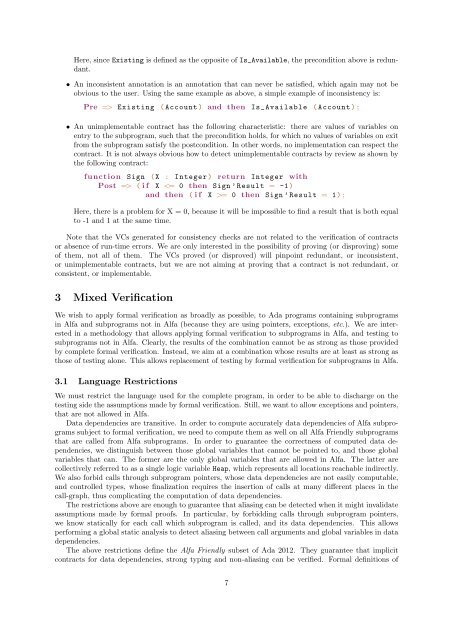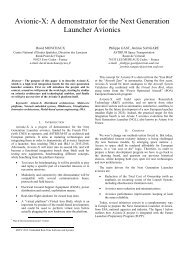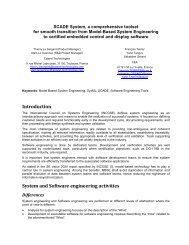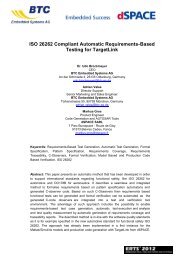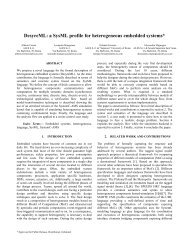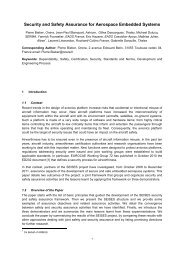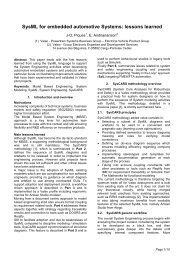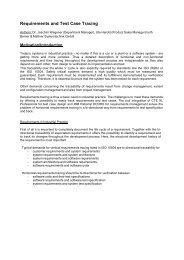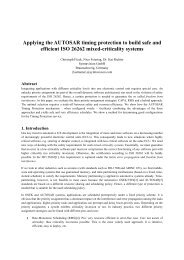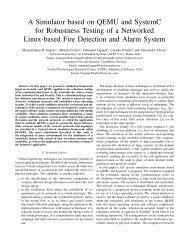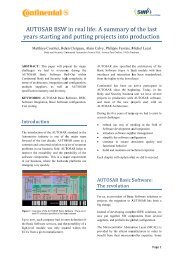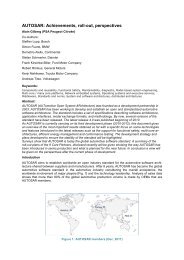Integrating Formal Program Verification with Testing
Integrating Formal Program Verification with Testing
Integrating Formal Program Verification with Testing
- No tags were found...
Create successful ePaper yourself
Turn your PDF publications into a flip-book with our unique Google optimized e-Paper software.
Here, since Existing is defined as the opposite of Is_Available, the precondition above is redundant.• An inconsistent annotation is an annotation that can never be satisfied, which again may not beobvious to the user. Using the same example as above, a simple example of inconsistency is:Pre => Existing ( Account ) and then Is_Available ( Account ) ;• An unimplementable contract has the following characteristic: there are values of variables onentry to the subprogram, such that the precondition holds, for which no values of variables on exitfrom the subprogram satisfy the postcondition. In other words, no implementation can respect thecontract. It is not always obvious how to detect unimplementable contracts by review as shown bythe following contract:function Sign (X : Integer ) return Integer <strong>with</strong>Post => ( i f X = 0 then Sign ’ Result = 1) ;Here, there is a problem for X = 0, because it will be impossible to find a result that is both equalto -1 and 1 at the same time.Note that the VCs generated for consistency checks are not related to the verification of contractsor absence of run-time errors. We are only interested in the possibility of proving (or disproving) someof them, not all of them. The VCs proved (or disproved) will pinpoint redundant, or inconsistent,or unimplementable contracts, but we are not aiming at proving that a contract is not redundant, orconsistent, or implementable.3 Mixed <strong>Verification</strong>We wish to apply formal verification as broadly as possible, to Ada programs containing subprogramsin Alfa and subprograms not in Alfa (because they are using pointers, exceptions, etc.). We are interestedin a methodology that allows applying formal verification to subprograms in Alfa, and testing tosubprograms not in Alfa. Clearly, the results of the combination cannot be as strong as those providedby complete formal verification. Instead, we aim at a combination whose results are at least as strong asthose of testing alone. This allows replacement of testing by formal verification for subprograms in Alfa.3.1 Language RestrictionsWe must restrict the language used for the complete program, in order to be able to discharge on thetesting side the assumptions made by formal verification. Still, we want to allow exceptions and pointers,that are not allowed in Alfa.Data dependencies are transitive. In order to compute accurately data dependencies of Alfa subprogramssubject to formal verification, we need to compute them as well on all Alfa Friendly subprogramsthat are called from Alfa subprograms. In order to guarantee the correctness of computed data dependencies,we distinguish between those global variables that cannot be pointed to, and those globalvariables that can. The former are the only global variables that are allowed in Alfa. The latter arecollectively referred to as a single logic variable Heap, which represents all locations reachable indirectly.We also forbid calls through subprogram pointers, whose data dependencies are not easily computable,and controlled types, whose finalization requires the insertion of calls at many different places in thecall-graph, thus complicating the computation of data dependencies.The restrictions above are enough to guarantee that aliasing can be detected when it might invalidateassumptions made by formal proofs. In particular, by forbidding calls through subprogram pointers,we know statically for each call which subprogram is called, and its data dependencies. This allowsperforming a global static analysis to detect aliasing between call arguments and global variables in datadependencies.The above restrictions define the Alfa Friendly subset of Ada 2012. They guarantee that implicitcontracts for data dependencies, strong typing and non-aliasing can be verified. <strong>Formal</strong> definitions of7


